Research: Science for Everyone
Would you like to learn more about specific projects underway in our group? The following articles about our work have appeared in the JILA Light & Matter quarterly newsletter during the past three years. They are written for people who've taken science classes in high school or college. If you haven't taken any science classes yet, read about some of our work in the Nuggets section below.
ULTRACOLD STRONTIUM
A Quantum Leap for Precision Lasers
To be the best they can be, optical atomic clocks need better clock lasers -- lasers that remain phase-coherent a hundred times longer than the very best conventional lasers... Read More»
Fermions in Collision
According to the laws of quantum mechanics, identical fermions at very low temperatures can't collide. These unfriendly subatomic particles, atoms, or molecules simply will not share the same piece of real estate with an identical twin... Read More»
Qubits in Action
Fellows Ana Maria Rey and Jun Ye have come up with a clever idea that should make it much easier to design a quantum computer based on alkaline-earth atoms such as strontium (Sr)... Read More»
The Right Stuff
It took them a matter of a couple of weeks to come up with a basic theoretical framework for a quantum computer based on alkaline-earth metals such as Sr... Read More»
Clock Talk
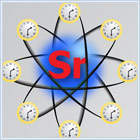 By late 2006, Fellow Jun Ye's clock team had raised the accuracy of its strontium (Sr)-lattice atomic clock to be just shy of that of the nation's primary time and frequency standard, the NIST-F1 cesium (Cs) fountain clock...
Read More»
By late 2006, Fellow Jun Ye's clock team had raised the accuracy of its strontium (Sr)-lattice atomic clock to be just shy of that of the nation's primary time and frequency standard, the NIST-F1 cesium (Cs) fountain clock...
Read More»
The Gravity of the Situation
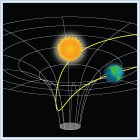 What sort of experiment could detect the effects of quantum gravity, if it exists? Theories that go beyond the Standard Model of physics include a concept that links quantum interactions with gravity...
Read More»
What sort of experiment could detect the effects of quantum gravity, if it exists? Theories that go beyond the Standard Model of physics include a concept that links quantum interactions with gravity...
Read More»
The South Broadway Shootout
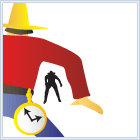 In the race to develop the world's best optical atomic clock, accuracy and precision are
what count. Accuracy is the degree to which a measurement of time conforms to time's true
value. Precision is a gauge of the exactness, or reproducibility, of the measurements.
Read More»
In the race to develop the world's best optical atomic clock, accuracy and precision are
what count. Accuracy is the degree to which a measurement of time conforms to time's true
value. Precision is a gauge of the exactness, or reproducibility, of the measurements.
Read More»
Magic Light
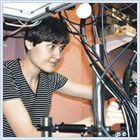 "In the right light, in the right time, everything is extraordinary," according to
photographer Aaron Rose. He could have just as easily been describing precision optical
spectroscopy experiments recently conducted by Research Associates Tanya Zelevinsky and
Tetsuya Ido, Graduate Students Martin Boyd and Andrew Ludlow, Fellow Jun Ye and collaborators
from Poland's Instytut Fizyki and NIST's Atomic Physics Division.
Read More»
"In the right light, in the right time, everything is extraordinary," according to
photographer Aaron Rose. He could have just as easily been describing precision optical
spectroscopy experiments recently conducted by Research Associates Tanya Zelevinsky and
Tetsuya Ido, Graduate Students Martin Boyd and Andrew Ludlow, Fellow Jun Ye and collaborators
from Poland's Instytut Fizyki and NIST's Atomic Physics Division.
Read More»
Partnership in Time
 There's only one way to prove you've invented a better atomic clock: Come out on top of
a comparison of your clock with one of the world's best atomic clocks: The NIST-F1 cesium
fountain atomic clock, the nation's primary time and frequency standard.
Read More»
There's only one way to prove you've invented a better atomic clock: Come out on top of
a comparison of your clock with one of the world's best atomic clocks: The NIST-F1 cesium
fountain atomic clock, the nation's primary time and frequency standard.
Read More»
Time Traveling
 Scientists in Fellow Jun Ye's lab are developing a high-precision optical atomic clock
linked to super-narrow optical transitions in ultracold, trapped strontium atoms. However,
unless the new clock is portable (it is not) or researchers figure out how to accurately
transmit its clock signal over a fiber optic network to NIST, the legendary strontium clock
will not be able to help the world keep better time.
Read More»
Scientists in Fellow Jun Ye's lab are developing a high-precision optical atomic clock
linked to super-narrow optical transitions in ultracold, trapped strontium atoms. However,
unless the new clock is portable (it is not) or researchers figure out how to accurately
transmit its clock signal over a fiber optic network to NIST, the legendary strontium clock
will not be able to help the world keep better time.
Read More»
There's Strontium in the Clock
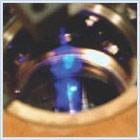 A high-powered JILA collaboration led by JILA Fellows Jun Ye and Chris Greene is making
important progress toward developing an ultrastable, high-accuracy optical atomic clock. The
new optical clock design will use a variety of laser sources including a femtosecond comb
and a diode laser stabilized with an optical cavity, which, in turn, is locked to a narrow
energy level transition in ultracold strontium atoms.
Read More»
A high-powered JILA collaboration led by JILA Fellows Jun Ye and Chris Greene is making
important progress toward developing an ultrastable, high-accuracy optical atomic clock. The
new optical clock design will use a variety of laser sources including a femtosecond comb
and a diode laser stabilized with an optical cavity, which, in turn, is locked to a narrow
energy level transition in ultracold strontium atoms.
Read More»
COLD MOLECULES
Beams in Collision
Brian Sawyer, Ben Stuhl, and Mark Yeo, research associate Dajun Wang, and Fellow Jun Ye fired cold hydroxyl (OH) radicals into a linear decelerator equipped with an array of highly charged electrodes and slowed the OH molecules to standstill.. Read More»
The Polar Molecule Express
The Jin and Ye groups recently crafted an entirely new form of matter -- tens of thousands of ultracold polar molecules in their lowest energy state... Read More»
Lights, Magnets, Action
When the Jin and Ye group collaboration wanted to investigate the creation of stable ultracold polar molecules, the researchers initially decided to make ultracold KRb (potassium-rubidium) molecules and then study their collision behavior Read More»
Exploring a Cold New World
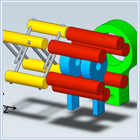 Researchers from the Ye, Bohn, and Greene groups are busy exploring a cold new world crawling
with polar hydroxyl radical (OH) molecules. The JILA experimentalists have already discovered
how to cool OH to "lukewarm" temperatures of 30 mK...
Read More»
Researchers from the Ye, Bohn, and Greene groups are busy exploring a cold new world crawling
with polar hydroxyl radical (OH) molecules. The JILA experimentalists have already discovered
how to cool OH to "lukewarm" temperatures of 30 mK...
Read More»
Ultimate Relaxation Experience
 Scientists anticipate that cold molecules will allow them to explore all kinds of exciting new
cold-matter physics. For instance, cold molecules should be able to interact with each other
over much longer distances than atoms.
Read More»
Scientists anticipate that cold molecules will allow them to explore all kinds of exciting new
cold-matter physics. For instance, cold molecules should be able to interact with each other
over much longer distances than atoms.
Read More»
Constant Vigilance
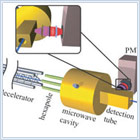 The fine structure constant is getting a lot of attention these days. Known as
The fine structure constant is getting a lot of attention these days. Known as  , it is the
"coupling constant," or measure of the strength of the electromagnetic force that governs
how electrons, muons, and light interact.
Read More»
, it is the
"coupling constant," or measure of the strength of the electromagnetic force that governs
how electrons, muons, and light interact.
Read More»
ULTRAFAST SCIENCE
Stalking the X-Ray Frequency Comb
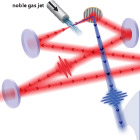 Fellow Jun Ye's group is methodically working its way toward the creation of an X-Ray frequency comb. Recently, senior research associate Thomas Schibli, graduate student Dylan Yost, Fellow Jun Ye, and colleagues from IMRA America, Inc. developed a high-performance, ultrastable fiber laser optical frequency comb.
Read More»
Fellow Jun Ye's group is methodically working its way toward the creation of an X-Ray frequency comb. Recently, senior research associate Thomas Schibli, graduate student Dylan Yost, Fellow Jun Ye, and colleagues from IMRA America, Inc. developed a high-performance, ultrastable fiber laser optical frequency comb.
Read More»
Every Breath You Take
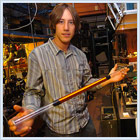 With every breath you take, you breathe out carbon dioxide and roughly 1000 other, different molecules. Some of these can signal the early onset of such diseases as asthma, cystic fibrosis, or cancer. Thanks to graduate student Mike Thorpe and his colleagues ...
Read More»
With every breath you take, you breathe out carbon dioxide and roughly 1000 other, different molecules. Some of these can signal the early onset of such diseases as asthma, cystic fibrosis, or cancer. Thanks to graduate student Mike Thorpe and his colleagues ...
Read More»
Molecular Fingerprinting
 Science sleuths have a new and powerful method for identifying (and investigating) atoms and
molecules, thanks to Graduate Student Mike Thorpe, Research Associate Kevin Moll, Senior Research
Associate Jason Jones, Undergraduate Student Assistant Ben Safdi, and Fellow Jun Ye. The new method
allows them to study molecular vibrations, rotations, and collisions as well as temperature changes
and chemical reactions.
Read More»
Science sleuths have a new and powerful method for identifying (and investigating) atoms and
molecules, thanks to Graduate Student Mike Thorpe, Research Associate Kevin Moll, Senior Research
Associate Jason Jones, Undergraduate Student Assistant Ben Safdi, and Fellow Jun Ye. The new method
allows them to study molecular vibrations, rotations, and collisions as well as temperature changes
and chemical reactions.
Read More»
The Quest for Stability
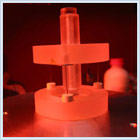 Fellow Jan Hall has been working on stabilizing the frequency of lasers since the 1960s.
Now, he, JILA Research Associate Mark Notcutt, Long-Sheng Ma (currently at BIPM in France),
and Fellow Jun Ye have devised an improved, compact, and less expensive method for
stabilizing lasers.
Read More»
Fellow Jan Hall has been working on stabilizing the frequency of lasers since the 1960s.
Now, he, JILA Research Associate Mark Notcutt, Long-Sheng Ma (currently at BIPM in France),
and Fellow Jun Ye have devised an improved, compact, and less expensive method for
stabilizing lasers.
Read More»
The Power of Mirrors
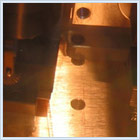 Three years ago Jun Ye decided to apply an old idea for amplifying and stabilizing
continuous-wave (cw) lasers to state-of-the-art ultrafast lasers. In 2002, Jason Jones, a
postdoctoral fellow with Jun, analyzed whether the build-up cavities used to amplify cw
laser outputs could be modified to work with ultrafast, mode-locked lasers.
Read More»
Three years ago Jun Ye decided to apply an old idea for amplifying and stabilizing
continuous-wave (cw) lasers to state-of-the-art ultrafast lasers. In 2002, Jason Jones, a
postdoctoral fellow with Jun, analyzed whether the build-up cavities used to amplify cw
laser outputs could be modified to work with ultrafast, mode-locked lasers.
Read More»
The World's First UV Frequency Comb
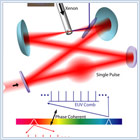 Jason Jones, Kevin Moll, Mike Thorpe, and Jun Ye have generated the world's first precise
frequency comb in the extreme ultraviolet (EUV) using a combination of an ultrafast mode-locked
laser and a precision high-finesse optical cavity. The EUV frequency comb consists of regularly
spaced sharp lines that extend into the EUV region of the electromagnetic spectrum.
Read More»
Jason Jones, Kevin Moll, Mike Thorpe, and Jun Ye have generated the world's first precise
frequency comb in the extreme ultraviolet (EUV) using a combination of an ultrafast mode-locked
laser and a precision high-finesse optical cavity. The EUV frequency comb consists of regularly
spaced sharp lines that extend into the EUV region of the electromagnetic spectrum.
Read More»
Nuggets
An Amazing New Atomic Clock
 Scientists all over the world are working hard to make better atomic clocks. When they succeed,
the new atomic clocks will help us better understand how our world works. One of the things they
will be used for is deep-space communications. Jun Ye and other scientists at JILA are working
hard to win a race to make the best atomic clock in the world.
Scientists all over the world are working hard to make better atomic clocks. When they succeed,
the new atomic clocks will help us better understand how our world works. One of the things they
will be used for is deep-space communications. Jun Ye and other scientists at JILA are working
hard to win a race to make the best atomic clock in the world.
Ye's clock uses laser light to make a cloud of extremely cold strontium atoms produce very fast, very exact ticks. Inside the clock, magic light holds the atoms very still while the laser shines on them, getting them to make ticks without disturbing them in any other way.
The new clock uses another laser to count the ticks. It has to use a laser because its ticks are too fast to count any other way. The laser that counts the ticks also works like a gear. It slows down the ticks enough so that the time can appear on a clock display.
When Jun Ye and his team are finished making the best atomic clock they can, it could eventually be a hundred times better than the cesium primary clock located at the National Institute of Standards and Technology!

